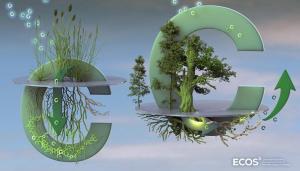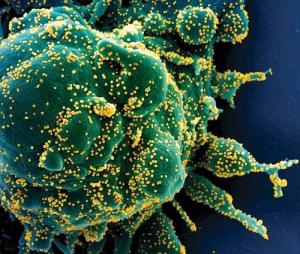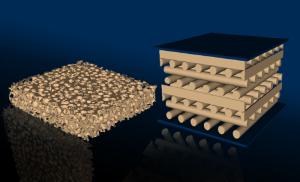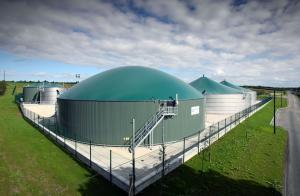LAB REPORT
Science and Technology Making Headlines
April 2, 2021


Elevated carbon dioxide has opposing effects on plant biomass and soil carbon, and these effects contrast between forests and grasslands. Image by Victor O. Leshyk/Center for Ecosystem Science and Society, Northern Arizona University.
Hit the dirt
The potential of soils to slow climate change by soaking up carbon may be less than previously thought.
The storage potential of one of the Earth’s biggest carbon sinks — soils — may have been overestimated, new research by Lawrence Livermore scientists shows. This could mean ecosystems on land are soaking up less of humanity’s emissions than expected, and more rapid global heating is occurring.
Soils and the plants that grow in them absorb about a third of the carbon emissions that drive the climate crisis, partly limiting the impact of fossil-fuel burning. Rising carbon dioxide levels in the atmosphere can increase plant growth and, until now, it was assumed carbon storage in soils would increase, too.
But the study, based on more than 100 experiments, found the opposite. When plant growth increases, soil carbon does not. The finding is significant because the amount of organic carbon stored in soils is about three times that in living plants and double that in the atmosphere. Soils also can store carbon for centuries, whereas plants and trees rot quickly after they die.


LLNL is one of the partner national laboratories in the ATOM consortium.
ATOM's family is growing
The Accelerating Therapeutics for Opportunities in Medicine (ATOM) consortium this week announced the U.S. Department of Energy’s Argonne, Brookhaven and Oak Ridge national laboratories are joining the consortium to further develop ATOM’s artificial intelligence (AI)-driven drug discovery platform.
The public-private ATOM consortium aims to transform drug discovery from a slow, sequential and high-risk process into a rapid, integrated and patient-centric model. Founded in 2017, ATOM is developing a pre-competitive, pre-clinical drug design platform that integrates diverse data types such as physicochemical properties, in vitro assay results and anonymized human clinical data, with AI, high-performance computing and advanced experimental technologies. The goal is to shorten the drug discovery timeline from five years to less than one year.
“It’s exciting to welcome three new national laboratories into the expanded ATOM consortium,” said Jim Brase, deputy associate director for computing at Lawrence Livermore National Laboratory and ATOM co-lead. “Their combined world-class expertise and experience in computing, simulation and machine learning will accelerate our progress toward molecular design of new therapeutics for the public good.”


A colorized scanning electron micrograph of a cell heavily infected with SARS-CoV-2 virus particles (yellow), isolated from a patient sample. Image courtesy of NIH/NIAID.
Bring out the big guns to fight COVID
More than a year into the COVID-19 pandemic, researchers seek alternative targets to the spike protein, whose rapid mutations threaten the effectiveness of current vaccines.
Mutations of the coronavirus threaten to block, or at least render less effective, the vaccines that are gaining widespread usage.
Those involved in the research to find a vaccine that will not only protect from COVID-19 but also variants acknowledge that development of new drugs will take a long time.
“Particularly for small molecules (meaning most pharmaceuticals), the timelines are such that we are not going to have a major impact on the pandemic,” said Jim Brase, a Lawrence Livermore National Laboratory) deputy associate director who co-chairs an industry-lab consortium for computational drug development. “But we would like to use the effort to make sure we have tools in place for future needs, so we’ll be in a better position next time around.”


At left, a traditional open-cell stochastic foam, and at right, a 3D-printed foam with the face-centered tetragonal lattice structure.
Putting foams to the test
Lawrence Livermore National Laboratory scientists recently published the results of a three-week experimental campaign at the Lab's Jupiter Laser Facility to test the performance of laser-heated additive manufactured foams.
The project helps support two major Laboratory focus areas, including helping to advance additive manufacturing and by enabling improvements in performance of hohlraums — which are laser-heated cavities that produce an X-ray radiation drive that implodes a deuterium-filled capsule.
The work also supports the advancement of the state-of-the-art in high energy density science. In particular, by enabling more efficient hohlraums, it should help reach the inertial confinement fusion (ICF) program goal of achieving ignition in the laboratory.
The major findings in the research showed that laser-heated additive manufactured foams behaved in many ways similarly to chemical (aerogel) foams of similar densities. The amount of backscattered laser light for a given laser intensity and the propagation speed of a thermal wave through the plasma were similar.


The two stainless-steel digesters in this Australian biogas plant will be fed with 100 tons of organic waste per day. Photo courtesy of Weltec Biopower GmbH.
Not all biogas is created equal
Many states are exploring the use of renewable natural gas to decarbonize their gas systems. Renewable natural gas tends to be a generic term that describes a variety of fuels, including hydrogen, synthetic gas and biogas.
To provide climate benefits, renewable natural gas fuels must result in a net reduction in methane emissions, since methane is a very potent greenhouse gas that is rapidly increasing the rate of near-term global warming.
But there are some other sources of biomethane, which could be harnessed and result in fewer, rather than more, emissions.
For example, some existing livestock operations, landfills and municipal treatment plants release methane directly into the atmosphere. Capturing those emissions and processing them to pipeline or transportation fuels would reduce overall climate pollution into the atmosphere.
A recent study from Lawrence Livermore National Laboratory found that organic sources, such as forest biomass and agricultural residue, also could be converted to energy sources, but are not considered viable source materials for biomethane. According to the study, the only organics that are considered appropriate for biomethane are those producing biogas from manure, wastewater, landfills and food waste, which normally ends up in landfills.





